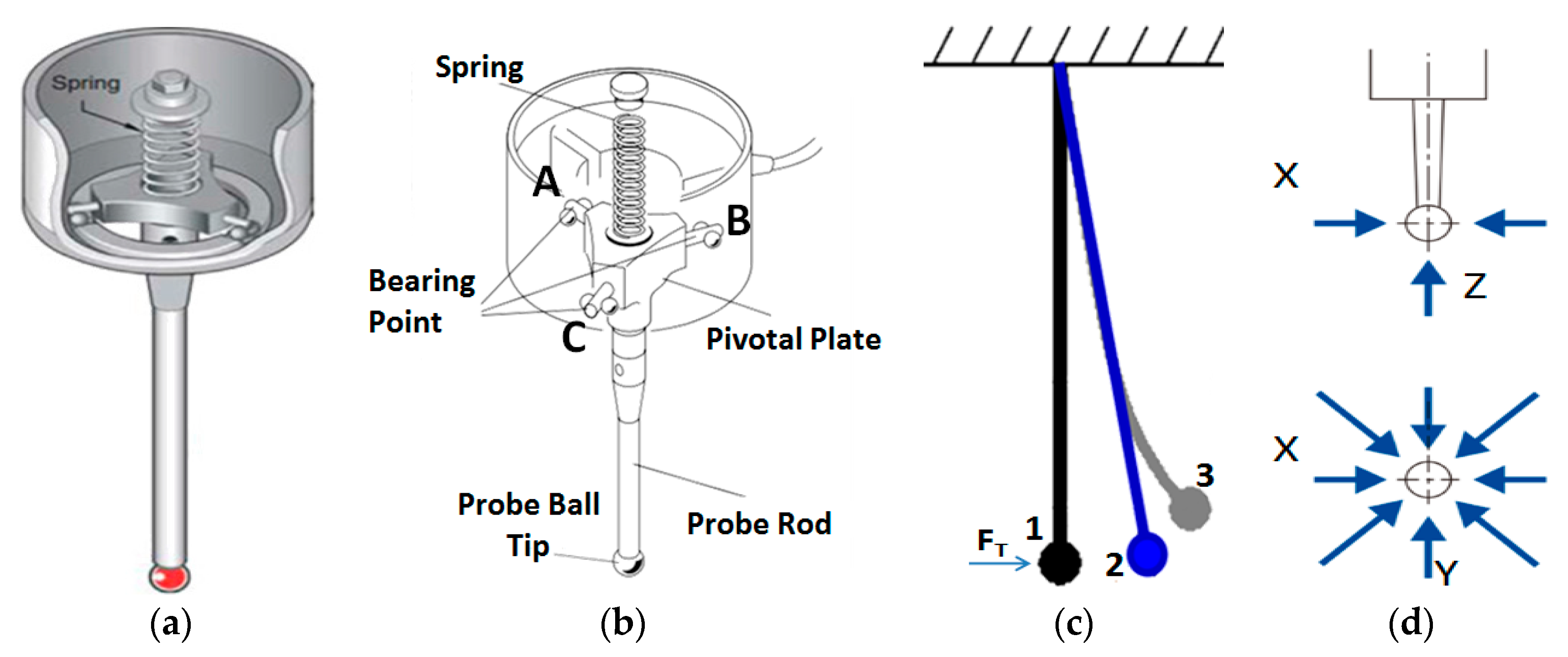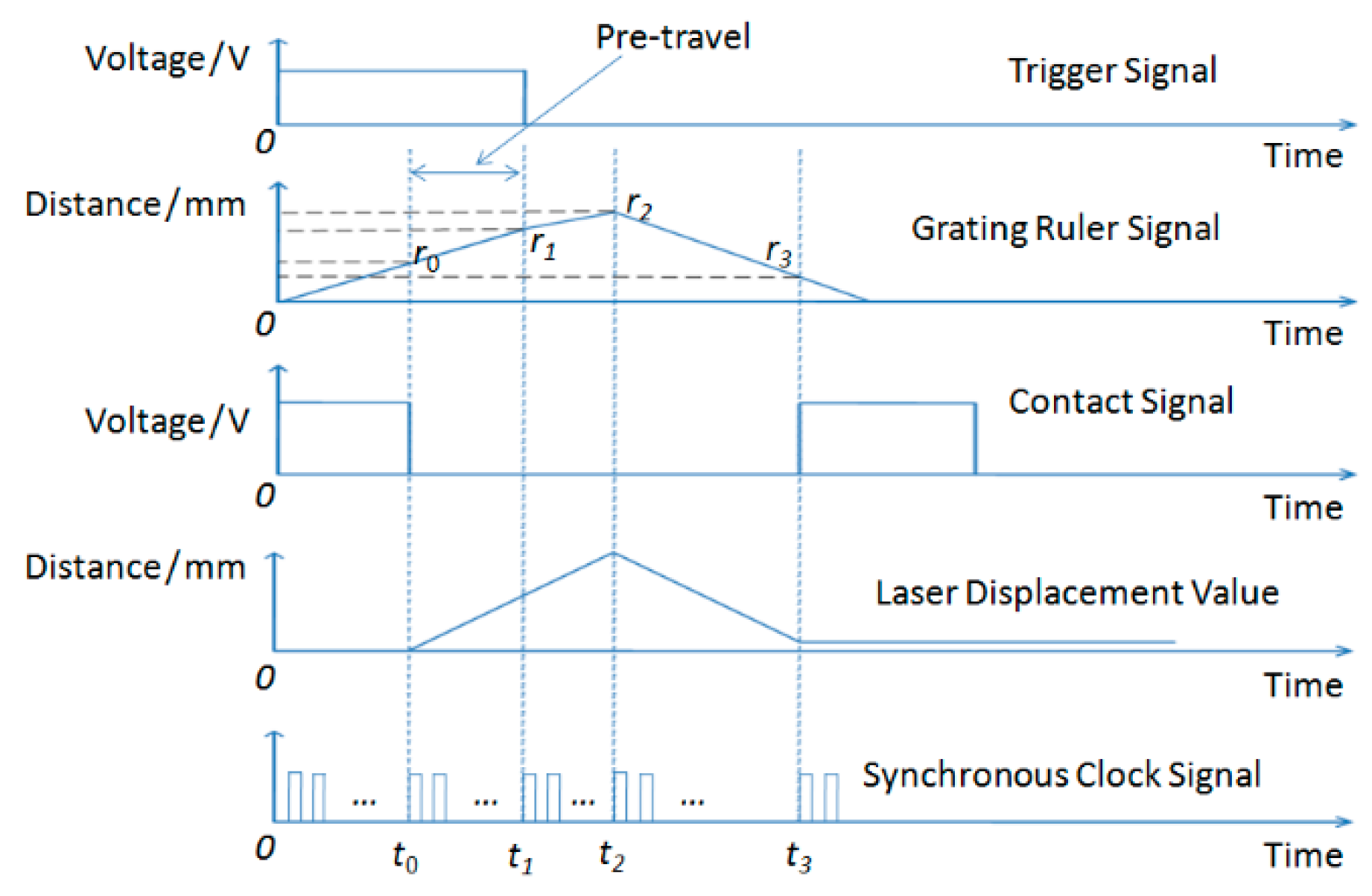Performance Evaluation and Compensation Method of Trigger Probes in Measurement Based on the Abbé Principle
Abstract
:1. Introduction
2. Methodology and Measurement Method
2.1. Abbe’s Principle
2.2. Measurement Method
3. Mathematical Modeling and Simulation
3.1. Rigid Displacement, LC
3.2. Deflection Displacement, Lp
3.3. Elastic Compression Displacement, Lk
3.4. The Pre-Travel of the Probe, Lpre
3.5. Modelling Simulation
4. Device and Experiments
5. Measurement Uncertainty
6. Conclusions
Author Contributions
Funding
Acknowledgments
Conflicts of Interest
References
- ISO. ISO 10360-2:2009 Geometrical Product Specifications (GPS)—Acceptance and Reverification Tests for Coordinate Measuring Machines (CMM)—Part 2: CMMs Used for Measuring Linear Dimensions; ISO: Genebra, Switzerland, 2009. [Google Scholar]
- ISO. ISO 10360-5:2010 Geometrical Product Specifications (GPS)—Acceptance and Reverification Tests for Coordinate Measuring Machines (CMM)—Part 5: CMMs Using Single and Multiple Stylus Contacting Probing Systems; ISO: Genebra, Switzerland, 2010. [Google Scholar]
- Woźniak, A.; Dobosz, M. Metrological feasibilities of CMM touch trigger probes. Part I: 3D theoretical model of probe pre-travel. Measurement 2003, 34, 273–286. [Google Scholar]
- Woźniak, A.; Dobosz, M. Metrological feasibilities of CMM touch trigger probes: Part II: Experimental verification of the 3D theoretical model of probe pre-travel. Measurement 2003, 34, 287–299. [Google Scholar] [CrossRef]
- Woźniak, A.; Dobosz, M. Influence of measured objects parameters on CMM touch trigger probe accuracy of probing. Precis. Eng. 2005, 29, 290–297. [Google Scholar] [CrossRef]
- Dobosz, M.; Woźniak, A. CMM touch trigger probes testing using a reference axis. Precis. Eng. 2005, 29, 281–289. [Google Scholar] [CrossRef]
- Woźniak, A.; Byszewski, M.; Jankowski, M. Setup for Triggering Force Testing of Touch Probes for CNC Machine Tools and CMMs. Meas. Sci. Rev. 2013, 13, 29–33. [Google Scholar] [CrossRef] [Green Version]
- Zhao, B.; Feng, G.; Yan, L.; Lijun, F. Study on pre-travel anisotropic characteristic of touch trigger probe and its calibration method. In Proceedings of the 2015 12th IEEE International Conference on Electronic Measurement & Instruments (ICEMI), Qingdao, China, 16–18 July 2015; IEEE: Piscataway, NJ, USA, 2015. [Google Scholar]
- Gao, F.; Zhao, B.H.; Li, Y. Novel pre-travel calibration method of touch trigger probe based on error separation. Yi Qi Yi Biao Xue Bao/Chin. J. Sci. Instrum. 2013, 34, 1581–1587. [Google Scholar]
- Li, Y.; Zeng, L.; Tang, K.; Li, S. A dynamic pre-travel error prediction model for the kinematic touch trigger probe. Measurement 2019, 146, 689–704. [Google Scholar] [CrossRef]
- Shen, Y.; Springer, M.E. A robust pre-travel model for touch trigger probes in coordinate metrology. J. Manuf. Sci. Eng. 1998, 120, 532–539. [Google Scholar] [CrossRef]
- Miguel, P.A.; King, T.; Abackerli, A.J. CMM touch trigger performance verification using a probe test apparatus. J. Braz. Soc. Mech. Sci. Eng. 2003, 25, 147–153. [Google Scholar] [CrossRef]
- Cauchick-Miguel, P.A.; King, T.G. Factors which influence CMM touch trigger probe performance. Int. J. Mach. Tools Manuf. 1998, 38, 363–374. [Google Scholar] [CrossRef]
- Aston, R.A.E.; Davis, J.; Stout, K.J. A probing question: A customer’s investigation into the directional variability of a coordinate measuring machine touch trigger probe. Int. J. Mach. Tools Manuf. 1997, 37, 1375–1382. [Google Scholar] [CrossRef]
- Shen, Y.L.; Moon, S.H. Investigation of point-to-point performance test of touch trigger probes on coordinate-measuring machines. Robot. Comput.-Integr. Manuf. 2001, 17, 247–254. [Google Scholar] [CrossRef]
- RenéMayer, J.R.; Ghazzar, A.; Rossy, O. 3D characterisation, modelling and compensation of the pre-travel of a kinematic touch trigger probe. Measurement 1996, 19, 83–94. [Google Scholar] [CrossRef]
- Li, S.; Zeng, L.; Feng, P.; Li, Y.; Xu, C.; Ma, Y. Accurate compensation method for probe pre-travel errors in on-machine inspections. Int. J. Adv. Manuf. Technol. 2019, 103, 2401–2410. [Google Scholar] [CrossRef]
- Park, J.J.; Kwon, K.; Cho, N. Development of a coordinate measuring machine (CMM) touch probe using a multi-axis force sensor. Meas. Sci. Technol. 2006, 17, 2380–2386. [Google Scholar] [CrossRef]
- Ma, X.; Qian, X.; Li, G.; Zhong, W. Modeling and simulation of CMMs probe trigger pre-travel error. In Proceedings of the International Conference on Intelligent Systems & Knowledge Engineering, Hangzhou, China, 15–16 November 2010; IEEE: Piscataway, NJ, USA, 2010. [Google Scholar]
- Cai, Y.L.; Cui, N.N.; Mo, X.; Yao, X.K.; Sun, W.Q. The pre-travel error study of electrical trigger probe in on-machine measurement. Key Eng. Mater. 2016, 693, 1466–1473. [Google Scholar] [CrossRef]
- Zhang, G.X. A study on the abbé principle and abbé error. Cirp Ann. 1989, 38, 525–528. [Google Scholar] [CrossRef]
- Thurner, K.; Quacquarelli, F.P.; Braun, P.F.; Dal Saiov, C.; Karrai, K. Fiber-based distance sensing interferometry. Appl. Opt. 2015, 54, 3051–3063. [Google Scholar] [CrossRef]
- Thurner, K.; Braun, P.F.; Karrai, K. Absolute distance sensing by two laser optical interferometry. Rev. Entific Instrum. 2013, 84, 115002. [Google Scholar] [CrossRef]
- Shen, Y.L.; Zhang, X. Modelling of pretravel for touch trigger probes on indexable probe heads on coordinate measuring machines. Int. J. Adv. Manuf. Technol. 1997, 13, 206–213. [Google Scholar] [CrossRef]
- Ningning, C.; Yonglin, C.; Manhuai, Z. The experimental research of the pre-travel error of the touch trigger probe in numerically controlled machine tool on-line inspecting system. Mach. Build. Autom. 2016, 3, 5–7. [Google Scholar]
- da Silva, V.N.; Nóbrega, L.H.; da Silva, F.A.; Silva, R.F.; de Aquino Silva, J.B. Simulation and analysis of touch trigger stylus performance. In Proceedings of the 21st Brazilian Congress of Mechanical Engineering, Natal, RN, Brazil, 24–28 October 2011; Available online: http://www.abcm.org.br/app/webroot/anais/cobem/2011/PDF/053601.pdf (accessed on 23 April 2020).
- BIPM; IEC; IFCC; ISO; IUPAC; IUPAP; OIML. JCGM 100:2008 Evaluation of Measurement Data—Guide to the Expression of Uncertainty in Measurement; 2008. Available online: https://ncc.nesdis.noaa.gov/documents/documentation/JCGM_100_2008_E.pdf (accessed on 23 April 2020).
- Salleh, M.R.; Yang, Q.P.; Jones, B. Evaluation of touch trigger probe measurement uncertainty using FEA. In Proceedings of the IMTC 2006–Instrumentation and Measurement Technology Conference, Sorrento, Italy, 24–27 April 2006. [Google Scholar]









| No. | Actual Measured Diameter Value (mm) | Compensated Diameter Value (mm) | Truth Value of the Diameter (mm) |
|---|---|---|---|
| 1 | 29.9853 | 29.9860 | 29.98604 |
| 2 | 29.9845 | 29.9857 | |
| 3 | 29.9857 | 29.9864 | |
| 4 | 29.9849 | 29.9856 | |
| 5 | 29.9852 | 29.9859 | |
| 6 | 29.9854 | 29.9861 | |
| 7 | 29.9856 | 29.9863 | |
| 8 | 29.9851 | 29.9858 | |
| 9 | 29.9843 | 29.9860 | |
| 10 | 29.9855 | 29.9858 | |
| Average value | 29.9852 | 29.9860 | |
| Error to nominal diameter | −0.00084 | −0.00004 |
| No. | Sources of Uncertainty | Magnitude | Type | Uncertainty |
|---|---|---|---|---|
| 1 | Probing | 0.034 μm | A | 0.034 μm |
| 2 | Calibration of probe | 0.030 μm | B | 0.030 μm |
| 3 | Uncertainty of standard sphere | 0.030 μm | B | 0.030 μm |
| 4 | Accuracy of grating scale displacement measurement | 0.020 μm | B | 0.020 μm |
| 5 | Repeatability deviation at zero position | 0.055 μm | A | 0.055 μm |
| 6 | Repeatability deviation at trigger position | 0.060 μm | A | 0.060 μm |
| 7 | Temperature measurement | 5 mK | B | 0.058 Lμm |
| 8 | Temperature distribution | 10 mK | A | 0.115 Lμm |
| 9 | Thermal expansion coefficient | 1.0 × 10−6/K | B | 0.010 Lμm |
| 10 | Error of cosine (gauge) | 0.1 mm/100 mm | B | 0.001 Lμm |
© 2020 by the authors. Licensee MDPI, Basel, Switzerland. This article is an open access article distributed under the terms and conditions of the Creative Commons Attribution (CC BY) license (http://creativecommons.org/licenses/by/4.0/).
Share and Cite
Ren, G.; Qu, X.; Chen, X. Performance Evaluation and Compensation Method of Trigger Probes in Measurement Based on the Abbé Principle. Sensors 2020, 20, 2413. https://doi.org/10.3390/s20082413
Ren G, Qu X, Chen X. Performance Evaluation and Compensation Method of Trigger Probes in Measurement Based on the Abbé Principle. Sensors. 2020; 20(8):2413. https://doi.org/10.3390/s20082413
Chicago/Turabian StyleRen, Guoying, Xinghua Qu, and Xiangjun Chen. 2020. "Performance Evaluation and Compensation Method of Trigger Probes in Measurement Based on the Abbé Principle" Sensors 20, no. 8: 2413. https://doi.org/10.3390/s20082413





